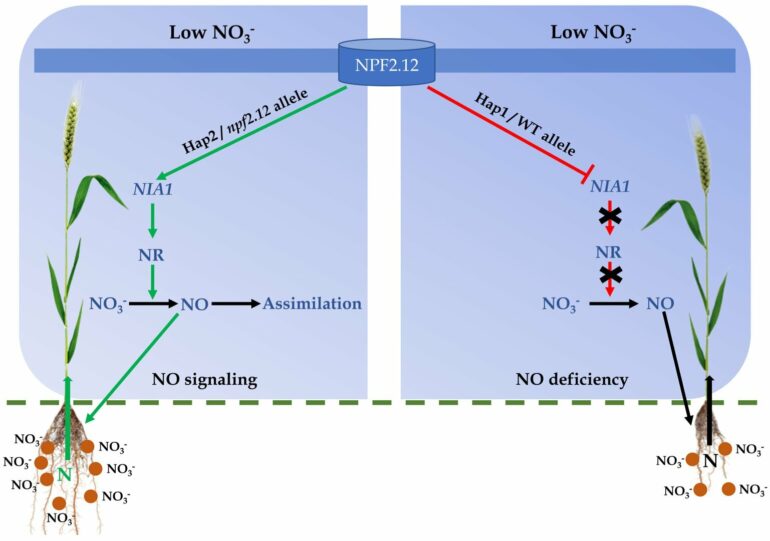Nitrogen as a fertilizer can increase yields. However, too much nitrogen can also have negative effects, such as groundwater pollution, high energy consumption in fertilizer production and the generation of climate-relevant gases. Science is therefore looking for ways to help crops thrive with less nitrogen.
Researchers at the University of Bonn have discovered gene variants of the nitrate sensor NPF2.12 that trigger a signal cascade chain at low soil nitrogen levels. This induces stronger root growth, resulting in improved nitrogen utilization. The study has been published in New Phytologist.
“We studied a large number of wheat and barley genotypes under different nitrogen supply conditions and analyzed their root architecture and nitrogen accumulation in the plants,” says lead author Md. Nurealam Sidiqqui of the Plant Breeding group at the University of Bonn’s Institute of Crop Science and Resource Conservation (INRES). The researchers studied a total of more than 220 different wheat and barley varieties from the last half century of plant breeding. “The wheat varieties studied were selected to cover the breeding history over the last 60 years,” explains Prof. Dr. Jens Léon of INRES Plant Breeding.
At the University of Bonn’s agricultural research campus Klein-Altendorf, the researchers studied these different varieties on trial plots with high nitrogen levels and, for comparison, on plots with low nitrogen application. The team then analyzed, among other aspects root traits characteristics and the nitrogen content of leaves and grains of each variety, and performed genome-wide genetic analyses to find correlations between DNA sequences and the corresponding traits, Prof. Léon further explains.
More roots take up more nitrogen from the soil
During the evaluation, the researchers came across NPF2.12. Certain variants of this gene caused plants to develop larger root systems when soil nitrogen supply was poor. “It is likely that the gene, or rather the protein it encodes, acts as a sensor that needs to be switched off when nitrogen levels in the soil are low in order to indirectly increase the messenger nitric oxide as part of a signaling cascade, which in turn induces root growth, thereby improving nitrogen utilization,” says Dr. Agim Ballvora from the INRES Plant Breeding, who is the paper’s corresponding author.
“Under low nitrogen conditions and in the presence of certain variants of the NPF2.12 gene, increased nitrogen content in leaves and grains is detectable compared to high nitrogen availability,” says Ballvora, who also collaborates with the PhenoRob Cluster of Excellence at the University of Bonn. Consequently, under adverse conditions these varieties give higher yield than those containing the alternative allele, emphasizes Siddiqui.
Variants of the NPF2.12 nitrate sensor help with nitrogen utilization
The researchers could demonstrate both in the laboratory and in the greenhouse that NPF2.12 is indeed responsible for this improved performance. Wheat plants with a defect in the NPF2.12 gene were analyzed. When nitrogen supply was poor, the corresponding lines having the defect npf2.12 allele behaved like cultivars that inherently have the helpful gene variant. “These results show that NPF2.12 is a negative regulator, whose reduced expression in corresponding cultivars results in more root growth and higher nitrogen content in the shoot through a sophisticated mechanism,” explains Prof. Dr. Gabriel Schaaf, member of the PhenoRob Cluster of Excellence from INRES Plant Nutrition.
The study falls within the scope of basic research, but also opens important possibilities for plant breeding. “Improved understanding of the genetic and molecular function of nitrogen sensing will accelerate the breeding of varieties with improved nitrogen use efficiency,” Ballvora says, looking to the future. However, this would require a better understanding of the individual steps in the signal cascade of the NPF2.12 sensor that result in stronger root growth under nitrogen deficiency.
More information:
Md. Nurealam Siddiqui et al, Convergently selected NPF2.12 coordinates root growth and nitrogen use efficiency in wheat and barley, New Phytologist (2023). DOI: 10.1111/nph.18820
Provided by
University of Bonn
Citation:
Researchers discover gene variants in wheat and barley that improve nitrogen utilization (2023, March 30)



